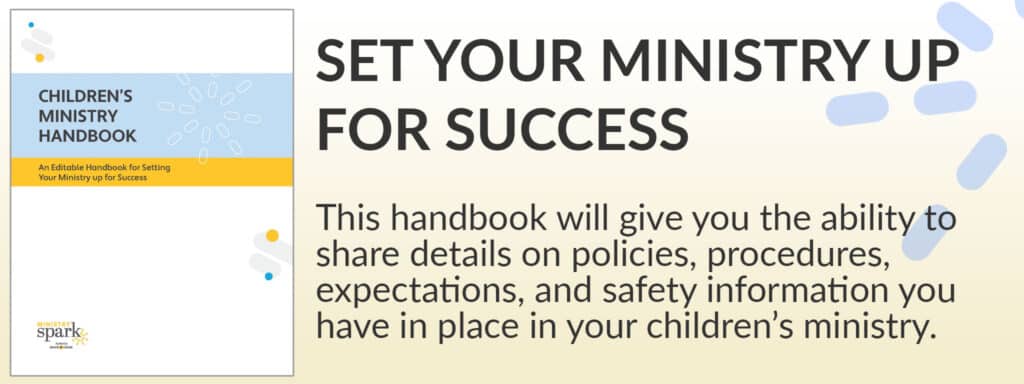A few years ago, before cell phones had GPS apps, I was driving on a long trip using a hand-held GPS device as my navigator. I knew I was supposed to stay on one interstate for hundreds of miles during my trip. But at one point, my GPS told me to exit the interstate.
Even though I knew I was supposed to stay on the road, I did what the GPS told me to do. As soon as I took the exit, it told me to get back on the interstate! I needed clarity on the path set before me and the direction I should go if I was going to get to my destination. Clarity would help me keep from getting sidetracked or distracted and taking wrong exits!
Setting Vision for Your Children’s Ministry
Vision in your children’s ministry sets the direction that gives clarity on where you’re going and what you’ll do to get there—the direction and the destination. Children’s ministries need a clear vision so you don’t take wrong exits and go down wrong paths. Vision brings clarity about the future for your ministry. If you know where you’re going, you can move in that direction and stay on the right road, even when distractions come.
I once heard a story of a person who was following a GPS that led her right into a lake! We need to not only have clarity about where we’re going, but also make sure our eyes are fixed on the right path. A children’s ministry without a clear vision may attempt to be and do too many things. Doing too many things can lead to distraction, ineffectiveness, and discouragement.
Vision in your children’s ministry sets the direction that gives clarity on where you’re going and what you’ll do to get there—the direction and the destination.
As you develop and evaluate your children’s ministry’s vision, remember these five things:
- The vision comes from God.
- The vision directs the “why” for your ministry.
- The vision motivates your people.
- The children’s ministry’s vision flows from the vision of the whole church.
- The vision is clear, concise, and memorable.

The vision comes from God.
The vision is the God-breathed future for your ministry. It answers the questions: “Where is our children’s ministry going?” and “What does God want for our children’s ministry?” It should be an inspiring and hope-filled picture from the heart of God.
As you develop your children’s ministry vision, begin by seeking the heart of God through prayer, with an open heart to hear from Him. Listen, dream, and be still before Him. Ask Him to reveal His vision for your ministry. The vision should be big enough that you can’t do it without God.
Ultimately, it’s not about crafting your own vision, but discovering His vision for your ministry. Saturate the entire process in prayer and spend time with God as you’re developing the vision statement.
The vision directs the “why” for your children’s ministry.
The vision tells people where your children’s ministry is going and clarifies the purpose. A compelling and inspiring vision will attract volunteers who want to serve in your ministry. People want to be a part of something life-changing and purposeful.
When you have a clear vision, you don’t just ask people to volunteer in your children’s ministry; you invite them to be part of the God-given vision and give them a deeper reason to serve.
The vision motivates your people.
A vision statement encourages unity, creates energy, brings life, and provides purpose for your volunteers, staff, kids, and families. It can unify your team and move your people toward action as everyone rallies around the vision. This type of change can be so good.
I’ve worked in churches with clear and compelling vision, but I’ve also been part of churches that didn’t know where they were going and what was important. The ones with clear vision grew not only in numbers and influence but were filled with people growing strong and deep in their faith as they lived out the God-give vision and served passionately to help fulfill it.
The vision should not be one of low stakes or low expectations. Children’s ministry should be life changing and earth shaking. Your vision should move kids and families to grow in their faith and discover their place in God’s big story.
It should impact and influence the programming your ministry executes, your teaching methods, your curriculum choice, your events, your values, your outreach, your church’s role in the community, the way you communicate with families, your volunteer roles—even your physical space and décor can be a vessel for vision-casting!


The children’s ministry’s vision flows from the vision of the whole church.
Your children’s ministry vision should be aligned with the vision of your church. An aligned vision brings unity and deeper impact. If you’re experiencing tension or discouragement, you may be out of alignment with your church’s vision.
As you develop your children’s ministry vision, you should ensure the destination for the entire church is mapped out and everyone is traveling in the same direction toward the same destination.
The vision is clear, concise, and memorable.
The vision should be easy for volunteers, kids, and parents to learn and declare. Repeat it often and in many ways. Look for opportunities to cast the vision through storytelling when God impacts lives through the ministry and celebrating wins. If it’s not memorable and understandable, it won’t stay at the forefront of people’s minds
The vision paints the dreams God has for your church’s future.
Questions to ask as you’re developing your vision statement for children’s ministry:
- What is your church’s vision?
- Where is the church going?
- How can your children’s ministry go in the same direction as the church?
- How do you envision your children’s ministry in the future?
- What is your ministry’s unique calling to meet the needs of its congregation and surrounding community?
- What does God want to accomplish through your children’s ministry?
- What does our ministry need to look like to accomplish this?
- What kind of children’s ministry do we want to be?
- What characterizes your ministry?
Questions to ask when evaluating your vision statement:
- Does our vision statement inspire and connect with people?
- Is the vision statement clear, concise, and memorable?
- Does the statement incorporate the values that are important to your church?
- Can someone who does not attend your church understand who your children’s ministry serves and desires to reach?
- Does the vision accurately reflect the church’s values?
- Can your volunteers easily remember and share the statement?
- How will you communicate your vision?
- What is the mission of your church and children’s ministry? What are the core values?

A vision statement is different from a mission statement, because a mission statement focuses on your ministry today and a vision statement focuses on your ministry’s future. Your mission statement determines what and how your ministry accomplishes the goals each day. The vision paints the dreams God has for your church’s future.
You won’t be tempted to take a wrong exit or drive your car into a lake when you have a clear path to your destination. A clear and compelling vision can combat discouragement, distraction, low-attendance, lack of volunteer commitment and passion, shallow faith, and lukewarm engagement and connection.
God already has a unique role for your children’s ministry in your community. He has brought the people to your church for a specific purpose. As a children’s ministry leader, you can discover how God is already moving in your ministry and articulate that in a compelling, challenging, and inspirational way through a vision statement.
When you know and follow the God-breathed vision for your children’s ministry, you’ll experience tremendous kingdom impact as kids and families grow in their faith and understand their identity as a child of God and their place in God’s big story.











